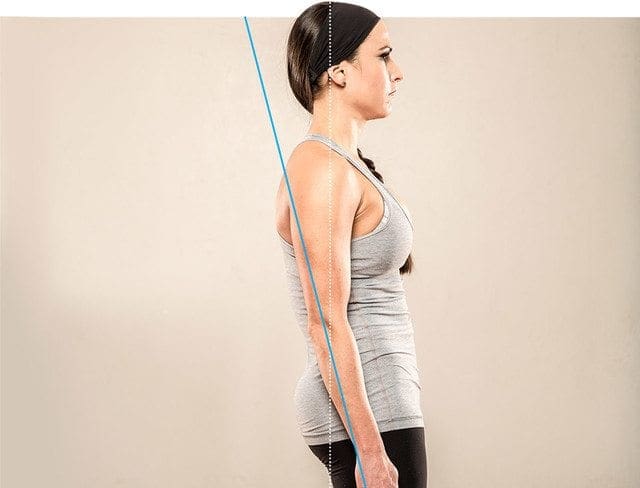Besides your personality body alignment says a lot about how your muscles and joints are working. Learn more about assessing your postural deviations and how to fix them!
Many studies show that how you feel and look is directly linked to your posture. Even the people know how important is to have good posture, most them don�t do anything to improve it.
Many of you probably live with deformed backs and imbalanced hips, and, of course, deal with the pain that you think is normal.
How dangerous can be to live with bad posture? It can lead to plenty of problems:
� Chronic back, shoulder and neck pain
� Headaches
� Injuries to feet, knees and hips
� Fatigue
� Stiffness
� Difficulty breathing
� Muscle atrophy and weakness
� Impingement and nerve compression
� Digestion issues
� Carpal tunnel syndrome
� Sciatica
If you are suffering from any of these problems, you should understand proper posture and learn about your own postural deviations.
Contents
Correcting Your Alignment
To solve a problem, you first need to find out what causes it. Most of the postural deviations occur as the muscles that work to hold a joint in place are imbalanced.
You can correct imbalances by strengthening the underactive muscles and to stretching the overactive muscles
Standing Assessment
For you who are not sure whether your posture is good or it needs a little correction, do this standing assessment first:
� Put on form-fitting clothes,
� Stand shoeless, tall but comfortable, do not trying to force yourself to stay in perfect posture.
� For an honest assessment, close your eyes and march slowly in place a few times.
� Have a friend take a full body picture of you
Here�s what a properly postured body should look like:
� Picture � posture
Standing Assessment Postural Deviations
I � Back, Shoulders, Hips, And Head
Here�s how you can correct these deviations:
Deviation 1: Sway Back � Hips Press Forward and Sit In Front Of the Ribs
Overactive muscles: erector spinae, gluteus maximus and medius, hamstrings and quadratus lumborum Stretches: Runner�s stretch, seated glute stretch, world�s greatest stretch, hamstring stretch, lying crossover, hamstring self-myofascial release (foam rolling)
Underactive muscles: Iliopsoas, rectus femoris (hip flexors and lower abs) and external obliques
Strengthening exercises: Cocoon, hanging leg raise, exercise ball pull-in and scissor kick
Deviation 2: Lower-Cross Syndrome
Excessive Curve In The Low Back, Pelvis Is Tilted Forward
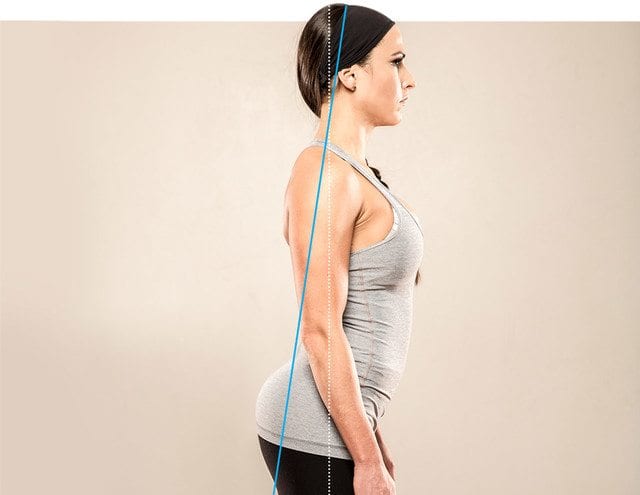
Overactive muscles: erector spinae (hip flexors and low back) and Iliopsoas
Stretches: quadriceps self-myofascial release, quadriceps stretch, pyramid stretch over ball, hug knees to chest and kneeling hip flexor,
Underactive muscles: gluteus maximus and abdominals
Strengthening exercises: Pelvic tilt to bridge, exercise-ball hip bridge, single-leg glute bridge, frog sit-up and leg elevated crunch,
Deviation 3: Rounded Shoulders
Shoulders In Front Of Ears
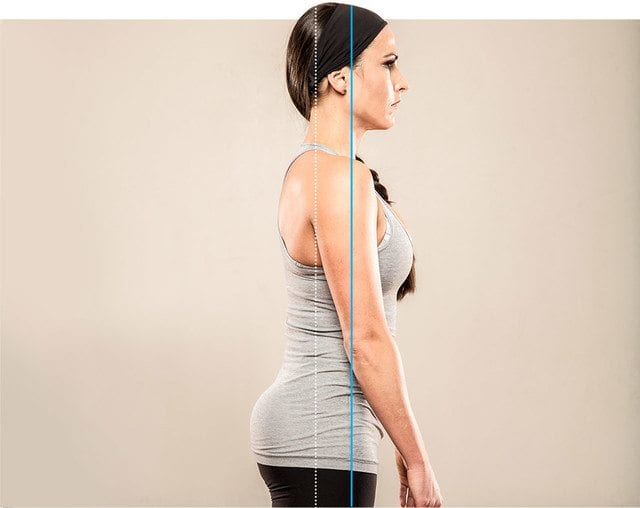
Overactive muscles: Pectoralis minor and major (chest)
Stretches: Front deltoid stretch, chest stretch on stability ball, dynamic chest stretch, elbows-back stretch, chair upper-body stretch
Underactive muscles: Rotator cuff, serratus anterior (muscles in the back surrounding the shoulder blades and rear delts) and lower trapezius,
Strengthening exercises: Seated cable row, shoulder external rotation, back fly with band, rear- delt row
Deviation 4: Forward Head
Ears In Front Of Shoulders
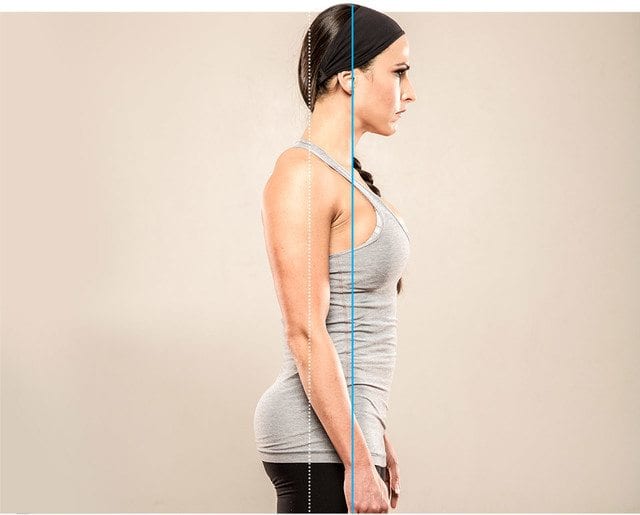
Overactive muscles: Neck extensors, levator scapula (muscles behind the neck that tilt the head back) and upper trapezius,
Stretches: Neck self-myofascial release, sternocleidomastoid stretch and chin to chest,
Strengthening exercises: Isometric front-neck exercise
Underactive muscles: Neck flexors (muscles in front of the neck that tilt the head forward)
Deviation 5: Upper-Cross Syndrome
Rounded Shoulders With An Excessive Curve
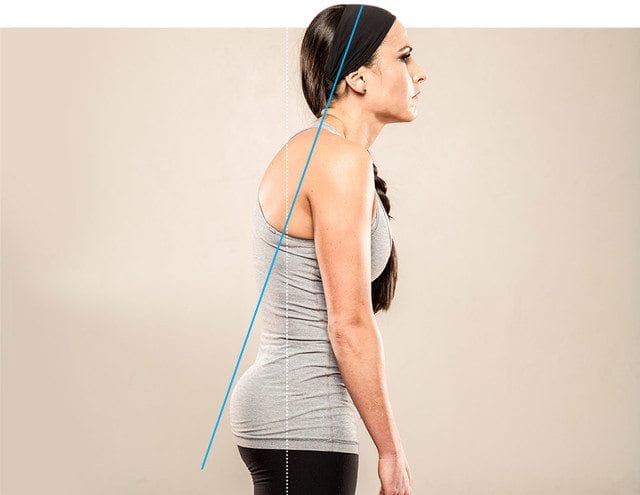
Overactive muscles: Trapezius, pectoralis major and minor, levator scapula, neck extensors (the back of your neck, upper back, traps, and chest)
Stretches: Neck self-myofascial release, front-delt stretch, chin to chest, chest stretch on stability ball, elbows-back stretch, chair upper-body stretch and dynamic chest stretch
Underactive muscles: Rotator cuff, rhomboids, lower trapezius, deep neck flexors (muscles in the back surrounding the shoulder blades, rear delts, and in front of the neck) and serratus anterior
Strengthening exercises: back fly with band, seated cable row, isometric front-neck exercise, rear-delt row and shoulder external rotation,
Deviation 6: Head Tilt
Head Tilted To One Side (Can Be Accompanied By Rotation toward That Side)
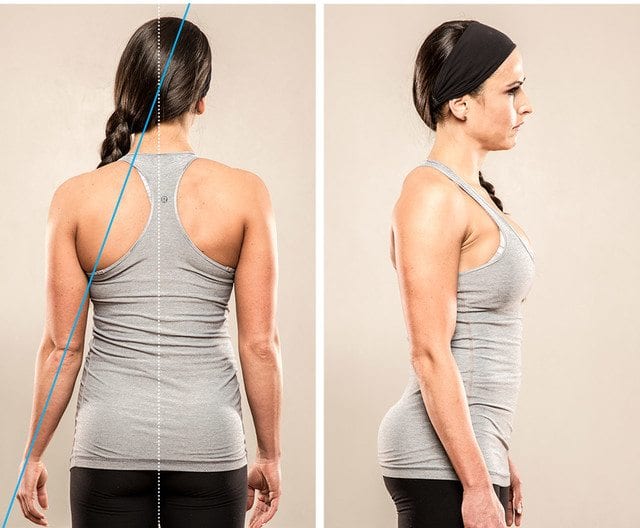
Overactive muscles: Sternocleidomastoid tilted toward the midline.
Stretches: Side neck stretch, sternocleidomastoid stretch and neck self-myofascial release,
Underactive muscles: Sternocleidomastoid tilted away from the midline.
Strengthening exercises: Perform daily activities (e.g., chewing, pulling, lifting, carrying, and using a cell phone) evenly on both sides, isometric side-neck exercise
Deviation 7: Uneven Shoulders
One Shoulder Sits Higher Than The Other
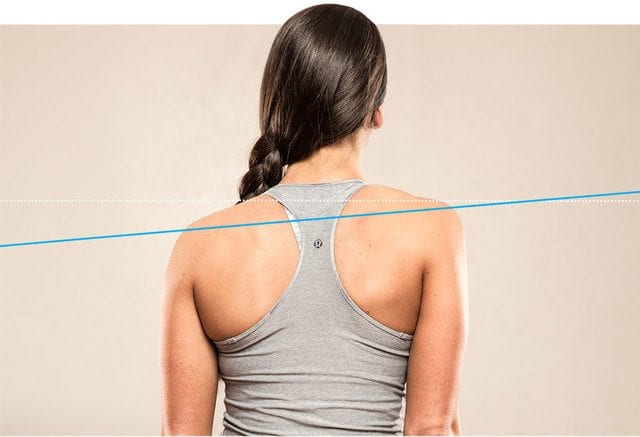
Overactive muscle: Trapezius (muscle running from the back of the neck into the shoulder girdle) on the elevated side
Stretches: Side neck stretch, neck self-myofascial release
Underactive muscles: Serratus anterior
Strengthening exercises: single-arm high-pulley row, perform daily activities on both sides
Deviation 8: Uneven Hips
One Hip Sits Higher Can Give The Perception Of Leg Length Discrepancy

Overactive muscles: hip abductors, internal and external obliques, erector spinae and quadratus lumborum on the raised side
Stretches: Runner�s stretch, world�s greatest stretch, IT-band stretch, IT-band self-myofascial release, seated glute stretch, lying cross-over, piriformis self-myofascial release, dancer�s stretch
Underactive muscles: Varies based on individual
Strengthening exercises: Avoid high-repetition andhigh-impact exercises until the pelvis is aligned.
II � Feet and Ankles
Like your other parts, your feet and ankles have a proper alignment.
Here are some common postural deviations for the feet and ankles:
Deviation 9: Feet Turned In
Toes Are Turned In Toward The Midline Of The Body

Overactive muscles: Tensor fasciae
Stretches: IT-band self-myofascial release and IT-band stretch,
Underactive muscles: Gluteus minimus and medius
Strengthening exercises: Bridge with band tension around thighs, squat with band tension around thighs and lateral tube walk,
Deviation 10: One Or Both Feet Turned Out � Toes Are Turned Out Away From The Midline Of The Body
Overactive muscles: deep external rotators and piriformis
Stretches: Seated glute stretch, piriformis self-myofascial release, lying cross-over, IT-band self-myofascial release, IT-band stretch and dancer�s stretch
Underactive muscles: obliques and hip flexors
Strengthening exercises: Cocoon, hanging leg raise and exercise ball pull-in,
Your Turn!
If you notice any of these imbalances, utilize the stretches and strengthening exercises.
Some examples
� If you have the upper-cross syndrome, do the strengthening exercises (rows and shoulder rotations on your back) 3 sets of 8-12 reps.
� Static stretching should be done at the end of your workout, holding each stretch for 15-30 seconds, and repeat a total of 3-5 sets.
Keep at it and soon you�ll notice some excellent results: You�ll look better, feel better and lift heavier!
Source, Model, Original Article : www.bodybuilding.com
Check this awesome site : www.bodybuilding.com
General Disclaimer, Licenses and Board Certifications *
Professional Scope of Practice *
The information herein on "Posture Power: How To Correct Your Body's Alignment" is not intended to replace a one-on-one relationship with a qualified health care professional or licensed physician and is not medical advice. We encourage you to make healthcare decisions based on your research and partnership with a qualified healthcare professional.
Blog Information & Scope Discussions
Welcome to El Paso's Premier Wellness and Injury Care Clinic & Wellness Blog, where Dr. Alex Jimenez, DC, FNP-C, a Multi-State board-certified Family Practice Nurse Practitioner (FNP-BC) and Chiropractor (DC), presents insights on how our multidisciplinary team is dedicated to holistic healing and personalized care. Our practice aligns with evidence-based treatment protocols inspired by integrative medicine principles, similar to those on this site and on our family practice-based chiromed.com site, focusing on naturally restoring health for patients of all ages.
Our areas of multidisciplinary practice include Wellness & Nutrition, Chronic Pain, Personal Injury, Auto Accident Care, Work Injuries, Back Injury, Low Back Pain, Neck Pain, Migraine Headaches, Sports Injuries, Severe Sciatica, Scoliosis, Complex Herniated Discs, Fibromyalgia, Chronic Pain, Complex Injuries, Stress Management, Functional Medicine Treatments, and in-scope care protocols.
Our information scope is multidisciplinary, focusing on musculoskeletal and physical medicine, wellness, contributing etiological viscerosomatic disturbances within clinical presentations, associated somato-visceral reflex clinical dynamics, subluxation complexes, sensitive health issues, and functional medicine articles, topics, and discussions.
We provide and present clinical collaboration with specialists from various disciplines. Each specialist is governed by their professional scope of practice and their jurisdiction of licensure. We use functional health & wellness protocols to treat and support care for musculoskeletal injuries or disorders.
Our videos, posts, topics, and insights address clinical matters and issues that are directly or indirectly related to our clinical scope of practice.
Our office has made a reasonable effort to provide supportive citations and has identified relevant research studies that support our posts. We provide copies of supporting research studies upon request to regulatory boards and the public.
We understand that we cover matters that require an additional explanation of how they may assist in a particular care plan or treatment protocol; therefore, to discuss the subject matter above further, please feel free to ask Dr. Alex Jimenez, DC, APRN, FNP-BC, or contact us at 915-850-0900.
We are here to help you and your family.
Blessings
Dr. Alex Jimenez DC, MSACP, APRN, FNP-BC*, CCST, IFMCP, CFMP, ATN
email: coach@elpasofunctionalmedicine.com
Multidisciplinary Licensing & Board Certifications:
Licensed as a Doctor of Chiropractic (DC) in Texas & New Mexico*
Texas DC License #: TX5807, Verified: TX5807
New Mexico DC License #: NM-DC2182, Verified: NM-DC2182
Multi-State Advanced Practice Registered Nurse (APRN*) in Texas & Multi-States
Multi-state Compact APRN License by Endorsement (42 States)
Texas APRN License #: 1191402, Verified: 1191402 *
Florida APRN License #: 11043890, Verified: APRN11043890 *
License Verification Link: Nursys License Verifier
* Prescriptive Authority Authorized
ANCC FNP-BC: Board Certified Nurse Practitioner*
Compact Status: Multi-State License: Authorized to Practice in 40 States*
Graduate with Honors: ICHS: MSN-FNP (Family Nurse Practitioner Program)
Degree Granted. Master's in Family Practice MSN Diploma (Cum Laude)
Dr. Alex Jimenez, DC, APRN, FNP-BC*, CFMP, IFMCP, ATN, CCST
My Digital Business Card
Licenses and Board Certifications:
DC: Doctor of Chiropractic
APRNP: Advanced Practice Registered Nurse
FNP-BC: Family Practice Specialization (Multi-State Board Certified)
RN: Registered Nurse (Multi-State Compact License)
CFMP: Certified Functional Medicine Provider
MSN-FNP: Master of Science in Family Practice Medicine
MSACP: Master of Science in Advanced Clinical Practice
IFMCP: Institute of Functional Medicine
CCST: Certified Chiropractic Spinal Trauma
ATN: Advanced Translational Neutrogenomics
Memberships & Associations:
TCA: Texas Chiropractic Association: Member ID: 104311
AANP: American Association of Nurse Practitioners: Member ID: 2198960
ANA: American Nurse Association: Member ID: 06458222 (District TX01)
TNA: Texas Nurse Association: Member ID: 06458222
NPI: 1205907805
| Primary Taxonomy | Selected Taxonomy | State | License Number |
|---|---|---|---|
| No | 111N00000X - Chiropractor | NM | DC2182 |
| Yes | 111N00000X - Chiropractor | TX | DC5807 |
| Yes | 363LF0000X - Nurse Practitioner - Family | TX | 1191402 |
| Yes | 363LF0000X - Nurse Practitioner - Family | FL | 11043890 |

